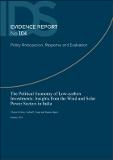| dc.contributor.author | Krishna, C | |
| dc.contributor.author | Sagar, A.D | |
| dc.contributor.author | Spratt, Stephen | |
| dc.coverage.spatial | India | en_GB |
| dc.date.accessioned | 2015-01-08T11:54:53Z | |
| dc.date.available | 2015-01-08T11:54:53Z | |
| dc.date.issued | 2015-01 | |
| dc.identifier.citation | Krishna, C.; Sagar, A.D. and Spratt, S. (2015) The Political Economy of Low-carbon Investments: Insights from the Wind and Solar Power Sectors in India, IDS Evidence Report 104, Brighton: IDS | en_GB |
| dc.identifier.uri | https://opendocs.ids.ac.uk/opendocs/handle/20.500.12413/5590 | |
| dc.description.abstract | The primary motivation behind this research is the need to accelerate the supply of renewable energy because of the important role that it plays in mitigating climate change and in fostering sustainable development.
Understanding past drivers for low-carbon investment can help us identify those for the future, and what could accelerate such investment. Investment in renewable energy can be modelled as a problem of technical asset allocation or optimisation at the firm or sectoral level, but is not entirely explained by this approach – the context in which actors are involved, their motivations and the wider systems in which they operate must also be taken into account. The interactions between actors may sometimes accelerate investment and sometimes prevent it; however, understanding the dynamics of these processes is crucial if we are to shape them. This study, which focuses on the wind and solar power sectors in India and China, aims to find and compare drivers for investment in renewable energy.
Our point of entry for this piece of the study is that India is already seeing significant investment activity in renewable energy. During 2010/11, investment in renewables grew by 62 per cent to US$13bn (although it slowed drastically in 2011/12 to US$6.5bn). In 2010 the Indian government announced a National Solar Mission that aimed to add 20 gigawatts (GW) of solar power generation capacity by 2020; wind power capacity has grown steadily at a compound annual growth rate of 17.9 per cent since 2007 and now contributes more than 20GW, or just over 70 per cent, of total renewable energy capacity. Almost all of this is private investment. However, these levels will need to increase sharply in the coming years and decades if India is to reach China’s levels (who, in 2013, became the world leader with US$67bn invested in renewables) and make a greater contribution to the US$1tn needed. | en_GB |
| dc.description.sponsorship | UK Department for International Development | en_GB |
| dc.language.iso | en | en_GB |
| dc.publisher | IDS | en_GB |
| dc.relation.ispartofseries | IDS Evidence Report;104 | |
| dc.rights.uri | http://creativecommons.org/licenses/by/3.0/ | en_GB |
| dc.subject | Environment | en_GB |
| dc.title | The Political Economy of Low-carbon Investments: Insights from the Wind and Solar Power Sectors in India | en_GB |
| dc.type | IDS Evidence Report | en_GB |
| dc.rights.holder | IDS | en_GB |
| dc.identifier.ag | OT/11009/7/1/1/546 | |


